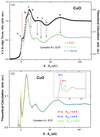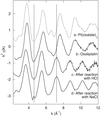issue contents
November 2006 issue

Cover illustration: Top right: an example of Laue diffraction patterns of a single crystal of calcium fluoride (30 mm diameter) (see Mukaide, Kajiwara, Noma and Takada, pages 484-488). The other three images are three-dimensional reconstructed images of part of the samples from section topographs recorded by step-scanning white X-ray section topography (top left and bottom right: 30 mm diameter and 30 mm thickness; bottom left: 60 mm diameter and 50 mm thickness). The shapes of a subgrain and a glide plane are illustrated by the yellow surface and the blue surface, respectively.
facility information
research papers
An atomic and molecular physics beamline with an energy range of 7.5–124 eV has been constructed at the National Synchrotron Radiation Laboratory, The University of Science and Technology of China, for studying the spectroscopy and dynamics of atoms, molecules and clusters.
A new hard X-ray diffraction beamline at BESSY is now under user operation, using a 7 T multipole wiggler as a powerful source of X-rays with energies up to 30 keV. The beamline is intended for single-crystal diffraction and resonant scattering experiments for the study of ordering phenomena, phase transitions and materials science.
A new optics scheme for liquid surface/interface spectrometers is introduced.
The synchrotron-radiation-stimulated etching of SiO2 thin films with a tungsten nano-pillar mask is presented.
Determination of the entire piezoelectric matrix of an L-arginine hydrochloride monohydrate single crystal by means of X-ray three-beam diffraction.
Small-angle X-ray scattering (SAXS) carried out using pinhole geometry and an area detector is a powerful and flexible technique, but subject to a number of limitations that can be greatly mitigated with relatively simple equipment and technique enhancements, as demonstrated on the ChemMatCARS SAXS/WAXS camera.
The rubber vulcanization process requires ZnO particles that hide the X-ray scattering of the filler. It is shown that ASAXS allows the determination of the filler structure factor which cannot be obtained by the usual SAXS method.
Homodyne and heterodyne X-ray intensity fluctuations in a latex suspension. Application to the relaxation of carbon-black-filled elastomers.
Energy scans at fixed momentum-transfers under specular X-ray reflectivity conditions near the LIII Cs+ resonance reveal the formation of a diffuse Gouy–Chapman layer at a charged aqueous surface, and also provide the anomalous f′ and f′′ terms of Cs ions in solution.
The Drude tail due to photo-excited carriers in single-walled carbon nanotubes has been observed in the mid-infrared region by using combination spectroscopy of synchrotron radiation and Ti:sapphire laser.
A new furnace, based on a halogen lamp, and a sample cell have been designed and constructed for in situ X-ray absorption spectroscopy experiments in conventional and dispersive mode (transmission and fluorescence geometries).
The Cu K-edge XANES spectra of several Cu(II) compounds have been analyzed within the multichannel multiple-scattering framework. The comparison between the experimental data and computations indicates that the experimental spectra can be accounted for by using two electronic configurations, 3d9 and 3d10 (
( being a hole from the ligand). These results suggest that the two-channels (3d9 and 3d10
being a hole from the ligand). These results suggest that the two-channels (3d9 and 3d10 ) scheme is the general case for the K-edge XANES of divalent copper systems.
) scheme is the general case for the K-edge XANES of divalent copper systems.
The degradation product of the anticancer drug oxaliplatin in the presence of chloride ions is studied by EXAFS. This precipitate is [Cl2-(diaminocyclohexane)-Pt(II)].
Step-scanning white X-ray section topography is a very useful and simple technique for visualizing the three-dimensional distribution of crystal defects within large single crystals.
computer programs
Open  access
access
 access
accessThe DXAS Calibration computer program provides a quantitative and automated solution to the problem of calibrating spectra from dispersive XAS beamlines.
current events
Free 



 journal menu
journal menu








































